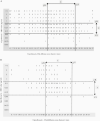Evaluation of Antimicrobial Susceptibility Profile in Salmonella Typhi and Salmonella Paratyphi A: Presenting the Current Scenario in India and Strategy for Future Management
- PMID: 35238369
- PMCID: PMC8892543
- DOI: 10.1093/infdis/jiab144
Evaluation of Antimicrobial Susceptibility Profile in Salmonella Typhi and Salmonella Paratyphi A: Presenting the Current Scenario in India and Strategy for Future Management
Abstract
Background: Systematic studies to estimate the disease burden of typhoid and paratyphoid in India are limited. Therefore, a multicenter study on the Surveillance of Enteric Fever in India was carried out to estimate the incidence, clinical presentation, and antimicrobial resistance (AMR) trend. The data presented here represent the national burden of AMR in Salmonella Typhi and Salmonella Paratyphi A.
Methods: Antimicrobial susceptibility testing was performed for S. Typhi and S. Paratyphi A (n = 2373) isolates collected prospectively during a 2-year period from November 2017 to January 2020.
Results: Of 2373 Salmonella isolates, 2032 (85.6%) were identified as S. Typhi and 341 (14.4%) were S. Paratyphi A. Approximately 2% of S. Typhi were multidrug-resistant (MDR), whereas all 341 (100%) of S. Paratyphi A isolates were sensitive to the first-line antimicrobials. Among 98% of ciprofloxacin nonsusceptible isolates, resistance (minimum inhibitory concentration [MIC] >0.5 µg/mL) was higher in S. Typhi (37%) compared with S. Paratyphi A (20%). Azithromycin susceptibility was 99.9% and 100% with a mean MIC of 4.98 μg/mL for S. Typhi and 7.39 μg/mL for S. Paratyphi A respectively. Ceftriaxone was the only agent that retained 100% susceptibility. Moreover, beta-lactam/beta-lactamase inhibitors showed potent in vitro activity against the study isolates.
Conclusions: Data obtained from this systematic surveillance study confirms the declining trend of MDR Salmonella isolates from India. The higher prevalence of ciprofloxacin nonsusceptibility enforces to limit its use and adhere to the judicious usage of azithromycin and ceftriaxone for enteric fever management.
Keywords: India; antimicrobial resistance; ciprofloxacin; surveillance; typhoid fever.
© The Author(s) 2021. Published by Oxford University Press for the Infectious Diseases Society of America.
Figures






References
-
- Parry MC. Epidemiological and clinical aspects of human typhoid fever. In: Mastroeni P, Maskell D, eds. Salmonella infections_ clinical, immunological and molecular aspects. Cambridge, UK: Cambridge University Press, 2006:1–24.
Publication types
MeSH terms
Substances
LinkOut - more resources
Full Text Sources
Miscellaneous

